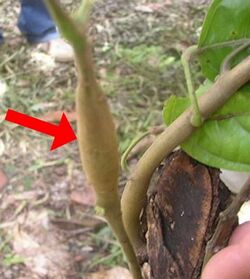Biology:Badnavirus
| Badnavirus | |
|---|---|
| Virus classification | |
| (unranked): | Virus |
| Realm: | Riboviria |
| Kingdom: | Pararnavirae |
| Phylum: | Artverviricota |
| Class: | Revtraviricetes |
| Order: | Ortervirales |
| Family: | Caulimoviridae |
| Genus: | Badnavirus |
Badnavirus is a genus of viruses, in the family Caulimoviridae order Ortervirales. Plants serve as natural hosts. There are 67 species in this genus. Diseases associated with this genus include: CSSV: leaf chlorosis, root necrosis, red vein banding in young leaves, small mottled pods, and stem/root swelling followed by die-back. Infection decreases yield by 25% within one year, 50% within two years and usually kills trees within 3–4 years.[1][2]
Taxonomy
The following species are recognized:[3]
- Aglaonema bacilliform virus
- Banana streak GF virus
- Banana streak IM virus
- Banana streak MY virus
- Banana streak OL virus
- Banana streak UA virus
- Banana streak UI virus
- Banana streak UL virus
- Banana streak UM virus
- Banana streak VN virus
- Birch leafroll-associated virus
- Blackberry virus F
- Bougainvillea chlorotic vein banding virus
- Cacao bacilliform Sri Lanka virus
- Cacao mild mosaic virus
- Cacao swollen shoot virus
- Cacao swollen shoot CD virus
- Cacao swollen shoot CE virus
- Cacao swollen shoot Ghana M virus
- Cacao swollen shoot Ghana N virus
- Cacao swollen shoot Ghana Q virus
- Cacao swollen shoot Togo A virus
- Cacao swollen shoot Togo B virus
- Cacao yellow vein banding virus
- Camellia lemon glow virus
- Canna yellow mottle associated virus
- Canna yellow mottle virus
- Citrus yellow mosaic virus
- Codonopsis vein clearing virus
- Commelina yellow mottle virus
- Cycad leaf necrosis virus
- Dioscorea bacilliform AL virus
- Dioscorea bacilliform AL virus 2
- Dioscorea bacilliform RT virus 1
- Dioscorea bacilliform RT virus 2
- Dioscorea bacilliform RT virus 3
- Dioscorea bacilliform SN virus
- Dioscorea bacilliform TR virus
- Dracaena mottle virus
- Epiphyllum mottle-associated virus
- Fig badnavirus 1
- Gooseberry vein banding associated virus
- Grapevine badnavirus 1
- Grapevine Roditis leaf discoloration-associated virus
- Grapevine vein clearing virus
- Green Sichuan pepper vein clearing-associated virus
- Ivy ringspot-associated virus
- Jujube mosaic-associated virus
- Kalanchoe top-spotting virus
- Mulberry badnavirus 1
- Pagoda yellow mosaic associated virus
- Pineapple bacilliform CO virus
- Pineapple bacilliform ER virus
- Piper yellow mottle virus
- Polyscias mosaic virus
- Rubus yellow net virus
- Schefflera ringspot virus
- Spiraea yellow leafspot virus
- Sugarcane bacilliform Guadeloupe A virus
- Sugarcane bacilliform Guadeloupe D virus
- Sugarcane bacilliform IM virus
- Sugarcane bacilliform MO virus
- Sweet potato pakakuy virus
- Taro bacilliform CH virus
- Taro bacilliform virus
- Wisteria badnavirus 1
- Yacon necrotic mottle virus
Structure
Viruses in Badnavirus are non-enveloped, with bacilliform geometries. These viruses are about 30 nm wide and 90-900 nm long. Genomes are circular and non-segmented.[1]
| Genus | Structure | Symmetry | Capsid | Genomic arrangement | Genomic segmentation |
|---|---|---|---|---|---|
| Badnavirus | Bacilliform | T=3 | Non-enveloped | Circular | Monopartite |
Life cycle
Viral replication is nuclear/cytoplasmic. Entry into the host cell is achieved by attachment of the viral proteins to host receptors, which mediates endocytosis. Replication follows the dsDNA(RT) replication model. DNA-templated transcription, specifically dsDNA-RT transcription is the method of transcription. The virus exits the host cell by nuclear pore export, and tubule-guided viral movement. Plants serve as the natural host. The virus is transmitted via a vector (cssv: mealybugs). Transmission routes are vector, mechanical, and seed borne.[1]
| Genus | Host details | Tissue tropism | Entry details | Release details | Replication site | Assembly site | Transmission |
|---|---|---|---|---|---|---|---|
| Badnavirus | Plants | None | Viral movement; mechanical inoculation | Viral movement | Nucleus | Cytoplasm | Mechanical inoculation: mealybugs; mechanical; wounds; seed |
References
- ↑ 1.0 1.1 1.2 "Viral Zone". ExPASy. http://viralzone.expasy.org/all_by_species/120.html. Retrieved 15 June 2015.
- ↑ "Genus: Badnavirus - Caulimoviridae - Reverse Transcribing DNA and RNA Viruses - International Committee on Taxonomy of Viruses (ICTV)". http://talk.ictvonline.org/ictv-reports/ictv_online_report/reverse-transcribing-dna-and-rna-viruses/w/caulimoviridae/1361/genus-badnavirus.[|permanent dead link|dead link}}]
- ↑ "Virus Taxonomy: 2020 Release". International Committee on Taxonomy of Viruses (ICTV). March 2021. https://ictv.global/taxonomy.
External links
- Viralzone: Badnavirus
- Genus: Badnavirus - Caulimoviridae - Reverse Transcribing DNA and RNA Viruses - International Committee on Taxonomy of Viruses (ICTV)[|permanent dead link|dead link}}]
Wikidata ☰ Q16911711 entry
 |


